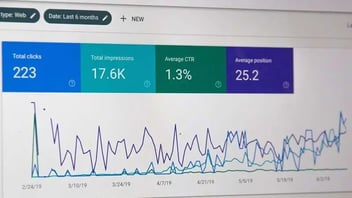10 strategie collaudate per la creazione di link
State lottando per migliorare le classifiche di ricerca del vostro sito web e superare i vostri concorrenti? Non siete soli.
Molte aziende trovano difficile creare backlink di alta qualità che rispettino le severe linee guida di Google e le politiche di spam per la ricerca web di Google. Ma cosa succederebbe se esistessero strategie di link-building collaudate e "white-hat" in grado di far schizzare in alto i vostri sforzi SEO senza rischiare penalizzazioni?

In questo articolo vi sveleremo dieci potenti tattiche utilizzate dagli esperti del settore per acquisire backlink di valore, aumentare la visibilità sui motori di ricerca e portare traffico mirato al vostro sito web. Che siate piccoli imprenditori o professionisti SEO, queste strategie vi aiuteranno a navigare nel complesso mondo del link building e a ottenere un successo a lungo termine nel panorama digitale in continua evoluzione.
1. Blogging ospite
Il guest blogging è una potente strategia di link building che prevede la creazione di contenuti di alta qualità per altri siti web del vostro settore o nicchia. Contribuendo con articoli preziosi e informativi a blog rinomati, potete affermarvi come autorità nel vostro settore, esporre il vostro marchio a un nuovo pubblico e, soprattutto, guadagnare preziosi backlink al vostro sito web. Questi backlink generano traffico di riferimento e aumentano la credibilità e l'autorità del vostro sito agli occhi dei motori di ricerca, migliorando in ultima analisi il vostro posizionamento.
Trovare opportunità di guest blogging pertinenti
Per massimizzare l'impatto dei vostri sforzi di guest blogging, è essenziale rivolgersi a siti web pertinenti al vostro settore e con un pubblico consistente. Ecco alcuni consigli per trovare le giuste opportunità di guest blogging:
-
Utilizzate gli operatori di ricerca di Google come "parola chiave" + "scrivi per noi" o "parola chiave" + "guest post" per trovare siti web che accettano contributi di ospiti.
-
Analizzate i profili di backlink dei vostri concorrenti per individuare i siti web che hanno pubblicato i loro contenuti.
-
Sfruttate le piattaforme di social media come X (Twitter) e LinkedIn per entrare in contatto con blogger e influencer della vostra nicchia.
-
Partecipate a eventi e conferenze di settore per fare rete con potenziali partner di guest blogging.
2. Creazione di link rotti
La costruzione di link rotti è un'efficace strategia di link-building che consiste nell'identificare i link rotti sui siti web rilevanti per il vostro settore e nel contattare i webmaster per suggerire un link sostitutivo dal vostro sito web. Questa tecnica è vantaggiosa per entrambe le parti: il webmaster può correggere un link rotto e migliorare l'esperienza utente del suo sito, mentre voi ottenete un prezioso backlink per i vostri contenuti.
Sfruttando la creazione di link non funzionanti, non solo potete acquisire backlink di alta qualità, ma anche posizionarvi come risorsa utile nella vostra nicchia.
Sebbene la creazione di link non funzionanti sia una tecnica più vecchia, rimane un metodo potente ed efficace per acquisire backlink.
Trovare i link interrotti
Per intraprendere con successo una campagna di creazione di link interrotti, dovete innanzitutto individuare i siti web con link interrotti pertinenti al vostro settore. Ecco un processo passo dopo passo che vi aiuterà a trovare queste opportunità:
-
Compilate un elenco di siti web rilevanti: iniziate a creare un elenco di siti web del vostro settore o della vostra nicchia che potrebbero avere pagine di risorse o link a contenuti esterni.
-
Utilizzate uno strumento di controllo dei link non funzionanti: Utilizzate uno strumento come Ahrefs o Semrush per analizzare i siti web del vostro elenco alla ricerca di link non funzionanti. Questi strumenti vi aiuteranno a identificare le pagine con errori 404 o altri problemi.
-
Analizzare i link non funzionanti: Una volta individuati i link non funzionanti, valutate il contenuto della pagina di collegamento per determinare se è rilevante per il vostro sito web. Cercate le opportunità in cui i vostri contenuti possano essere sostituiti in modo adeguato.
-
Creare contenuti sostitutivi: Se non disponete di contenuti esistenti che corrispondano al link interrotto, prendete in considerazione la creazione di nuovi contenuti che colmino la lacuna e forniscano valore al pubblico del sito web di collegamento.
3. Creazione di link a pagine di risorse
Le pagine di risorse sono elenchi curati di risorse utili su un argomento specifico, progettati per fornire valore ai lettori aggregando i migliori contenuti in una particolare nicchia. Sono preziose per la link building, perché il loro scopo principale è quello di rimandare ad altri siti web, il che le rende un obiettivo naturale per l'acquisizione di backlink rilevanti e di alta qualità.
Assicurarsi un link su una pagina di risorse ben consolidata può portare traffico di riferimento mirato, aumentare l'autorità del vostro sito e influire positivamente sulle vostre classifiche di ricerca grazie all'elevato PageRank e all'autorità del dominio che spesso queste pagine possiedono.
Strategie per trovare pagine di risorse rilevanti
Per massimizzare l'impatto degli sforzi di link-building delle pagine di risorse, è fondamentale trovare pagine rilevanti per la vostra nicchia con un'elevata autorità di dominio. Ecco alcune strategie per aiutarvi a individuare le migliori opportunità di pagine di risorse:
-
Ricerche su Google: Utilizzate operatori di ricerca mirati per trovare pagine di risorse nel vostro settore. Alcuni esempi sono:
-
"parola chiave" + "risorse"
-
"parola chiave" + "link utili"
-
"parola chiave" + "risorse utili"
-
-
Analisi dei concorrenti: Indagate i profili di backlink dei vostri concorrenti utilizzando strumenti SEO per identificare le pagine di risorse che si collegano ai loro contenuti. Se una pagina rimanda a un vostro concorrente, è molto probabile che anche lui sia disposto a rimandare ai vostri contenuti.
-
Blog e pubblicazioni di settore: Esplorate i blog e le pubblicazioni più popolari della vostra nicchia per trovare pagine di risorse o raccolte di link che raccolgono regolarmente i contenuti migliori.
|
Metodo |
Vantaggi |
Svantaggi |
|
Ricerche su Google |
Gratuite e facili da eseguire |
Può essere dispendioso in termini di tempo filtrare i risultati |
|
Analisi dei concorrenti |
Identifica opportunità di link comprovate |
Richiede strumenti a pagamento, come Semrush o Ahrefs. |
|
Blog e pubblicazioni di settore |
Pagine di risorse di alta qualità e specifiche della nicchia |
Limitato a pubblicazioni note nel vostro settore |
4. Menzioni di marchi non collegati
Le menzioni di marchi non collegati si riferiscono a casi in cui il vostro marchio, prodotto o servizio viene citato in un sito web senza un collegamento ipertestuale al vostro sito. Queste menzioni indicano che l'autore o il proprietario del sito web conosce il vostro marchio e lo considera abbastanza rilevante da includerlo nei suoi contenuti. Il potenziale di link-building risiede nel fatto che questi siti web hanno già mostrato interesse per il vostro marchio, rendendoli più propensi ad aggiungere un link al vostro sito se richiesto.
Convertendo le menzioni del marchio senza link in menzioni con link, è possibile:
-
Aumentare il traffico di riferimento del vostro sito
-
Aumentare la visibilità e la credibilità online del vostro marchio
-
Migliorare il posizionamento nei motori di ricerca grazie a backlink di alta qualità e rilevanza
Le menzioni del marchio non linkate sono "frutti a basso impatto" nella link building, in quanto richiedono uno sforzo minore per essere acquisite rispetto ad altre strategie come il guest posting o la creazione di broken link.
Come trovare menzioni di marchi non linkati
Per trovare le menzioni di marchi non linkati, è possibile utilizzare una combinazione di strumenti e tecniche, quali:
-
Google Alerts: Impostate avvisi per il nome del vostro marchio, i nomi dei prodotti e del personale chiave per ricevere notifiche ogni volta che vengono menzionati online.
-
Strumenti di monitoraggio dei social media: Piattaforme come Hootsuite, Mention o Brand24 possono aiutarvi a monitorare le menzioni del marchio sui vari canali dei social media e sul web.
-
Strumenti SEO: Offrono funzioni di monitoraggio delle menzioni del marchio che aiutano a identificare le menzioni non collegate e ad analizzare il loro potenziale di creazione di link.
-
Ricerche manuali: Eseguite ricerche regolari su Google per il nome del vostro marchio e le parole chiave correlate per trovare le menzioni recenti che gli strumenti automatici potrebbero non aver rilevato.
Una volta identificate le menzioni non collegate al marchio, classificatele in base alla rilevanza del sito web, all'autorità del dominio e al contesto in cui il vostro marchio viene menzionato.
5. Analisi dei backlink dei concorrenti
L'analisi dei backlink dei vostri concorrenti è fondamentale per sviluppare una strategia di link-building di successo. Comprendendo dove i vostri rivali acquisiscono i loro link, potete ottenere preziose informazioni sulle tattiche e sulle fonti che funzionano bene nella vostra nicchia. Questa conoscenza vi consente di:
-
Identificare le lacune di link
-
Scoprire nuove prospettive di link
-
Affinare la strategia dei contenuti
-
Fare un benchmark delle vostre prestazioni
Sfruttando l'analisi dei backlink dei concorrenti, potete sviluppare una strategia di link-building più mirata ed efficiente, che vi aiuti a ottenere un vantaggio competitivo nel vostro mercato.
Strumenti e metodi per l'analisi dei backlink dei concorrenti
Per condurre un'analisi approfondita dei backlink dei concorrenti, è possibile utilizzare una combinazione di strumenti e metodi, quali:
-
Strumenti di analisi dei backlink: Questi strumenti offrono funzioni complete di analisi dei backlink che consentono di analizzare i profili dei backlink dei concorrenti, identificando le fonti di link più preziose e i contenuti che attirano il maggior numero di link.
-
Ricerca manuale: Esplorate i siti web dei vostri concorrenti per identificare le loro pagine più linkate e i tipi di contenuti che sembrano risuonare con il loro pubblico.
-
Ricerche di settore: Rimanete aggiornati sulle ultime tendenze, pubblicazioni e influencer della vostra nicchia per scoprire potenziali opportunità di link che i vostri concorrenti potrebbero perseguire.
6. Creazione di link infografici
Le infografiche sono emerse come uno degli strumenti più potenti per attrarre backlink nel panorama del content marketing. Questi contenuti visivamente avvincenti e facilmente digeribili sono altamente condivisibili e possono catturare rapidamente l'attenzione di un vasto pubblico. L'efficacia delle infografiche per il link-building risiede nella loro capacità di:
-
Semplificare informazioni complesse: Le infografiche suddividono argomenti complessi in rappresentazioni visive facilmente comprensibili, rendendole interessanti per un'ampia gamma di spettatori.
-
Migliorare la condivisibilità: La natura visiva delle infografiche le rende altamente condivisibili su varie piattaforme, tra cui social media, blog e siti web, aumentando il loro potenziale di attrazione di backlink.
-
Dimostrare la propria competenza: Le infografiche ben progettate mostrano l'esperienza e la leadership di pensiero del vostro marchio nel vostro settore, incoraggiando gli altri a collegarsi ai vostri contenuti come una risorsa preziosa.
-
Migliorano la varietà dei contenuti: Le infografiche aggiungono varietà al vostro mix di contenuti, fornendo un'alternativa fresca ai tradizionali post e articoli del blog, che può contribuire ad attrarre link da una gamma più ampia di fonti.
Strategia per promuovere le infografiche e ottenere backlink
Una volta creata un'infografica di alta qualità, è essenziale promuoverla efficacemente per massimizzare il suo potenziale di link-building. Ecco una strategia per promuovere l'infografica e assicurarsi i backlink:
-
Pubblicare sul vostro sito web
-
Condividere sui social media
-
Raggiungere gli influencer del settore
-
Inviate alle directory di infografiche
-
Effettuare ricerche mirate
-
Sfruttare la promozione a pagamento
7. PR digitali
Le PR digitali sono un approccio strategico per costruire la presenza e la reputazione online di un marchio attraverso la creazione e la distribuzione di contenuti degni di nota, lo sviluppo di relazioni con influencer e giornalisti chiave e la gestione delle menzioni online del marchio. Nel contesto del link building, le PR digitali svolgono un ruolo cruciale:
-
guadagnare backlink di alta qualità
-
Aumentare la visibilità del marchio
-
Stabilire una leadership di pensiero
-
Favorire le relazioni con gli influencer
Secondo l'esperienza dell'agenzia bizZzdev, le digital PR sono la tecnica di maggior successo per le aziende che vogliono creare backlink di alta qualità e migliorare la propria visibilità online. Sfruttando il potere delle PR digitali, le aziende possono guadagnare backlink autorevoli, guidare il traffico di riferimento e affermare il proprio marchio come leader del settore.
Esempi di campagne di PR digitali di successo
Per illustrare la potenza delle PR digitali per il link building, diamo un'occhiata ad alcune campagne di successo che hanno generato backlink significativi:
-
Oreo "Oreo Thins Protection Program" (2022): Una campagna umoristica che promuove i biscotti Oreo Thins e che ha generato copertura e backlink da Adweek, Marketing Dive e The Drum.
-
"Reverse Selfie" di Dove (2021): Un video efficace che mette in evidenza la pressione che le giovani ragazze devono affrontare sui social media, generando copertura e backlink da parte di CNN, The Guardian e Teen Vogue.
-
LEGO "Ricostruisci il mondo" (2021): Una campagna fantasiosa che incoraggia la creatività dei bambini e che ha generato copertura e backlink da Forbes, Fast Company e The Drum.
-
"Earth Day 2023" di Patagonia: Una campagna che promuove la sostenibilità e la responsabilità ambientale, generando copertura e backlink da parte di The New York Times, Business Insider e Sustainable Brands.
-
Wendy's "Rick and Morty" (2022): Una partnership con la popolare serie animata, che ha generato un'eco sui social media e una copertura da parte di AdAge, IGN e Comicbook.com.
Questi esempi recenti dimostrano come i marchi di vari settori utilizzino campagne di PR digitali creative, tempestive e socialmente rilevanti per generare copertura mediatica, coinvolgimento e backlink di alta qualità.
8. Tecnica del grattacielo
La tecnica del grattacielo è una strategia di link-building che prevede l'identificazione di contenuti popolari e performanti nella vostra nicchia e la creazione di una versione superiore di quei contenuti per attirare backlink. Il nome "grattacielo" deriva dalla creazione di un contenuto che si erge più in alto degli altri, proprio come un grattacielo si staglia nello skyline di una città. La tecnica funziona in questo modo:
-
Trovare contenuti di successo: Individuare i contenuti della propria nicchia che hanno già ottenuto buoni risultati nell'attrarre backlink e condivisioni sociali.
-
Creare una versione superiore: Produrre un contenuto che superi l'originale in termini di qualità, profondità e valore, rendendolo la nuova risorsa di riferimento sull'argomento.
-
Promuovere il contenuto: Contattare i siti web che rimandano al contenuto originale e altri siti pertinenti per promuovere la nuova versione migliorata e assicurarsi i backlink.
Sfruttando il successo di un contenuto esistente e creando un'alternativa superiore, la tecnica del grattacielo può aiutarvi ad attirare backlink di alta qualità e ad affermare il vostro sito web come risorsa di valore nel vostro settore.
Il processo di ricerca dei contenuti da "grattare"
Per trovare contenuti che valgano la pena di essere "grattati", seguite i seguenti passaggi:
-
Identificare le parole chiave pertinenti
-
Ricerca dei contenuti più performanti
-
Analizzare i contenuti
-
Valutare il potenziale di backlink
-
Scegliere il candidato migliore
Seguendo questo processo, è possibile identificare i contenuti maturi per la tecnica skyscraper e massimizzare le possibilità di creare un contenuto di successo che attiri backlink.
9. Creazione di link di testimonianza
Il Testimonial Link Building è una strategia che sfrutta il potere delle recensioni e dei consensi positivi per garantire backlink preziosi al vostro sito web. Fornendo testimonianze di prodotti, servizi o aziende che sostenete sinceramente, potete spesso guadagnare un backlink dal loro sito web, poiché molte aziende presentano le testimonianze dei clienti su pagine dedicate o accanto alle loro offerte. Il potere delle testimonianze per il link-building risiede in quanto segue:
-
Stabilire fiducia e credibilità: Le testimonianze servono come prova sociale, dimostrando che gli altri si fidano e apprezzano il prodotto o il servizio che sostenete, il che può far apparire il vostro sito web più credibile per associazione.
-
Creare relazioni: Fornendo una testimonianza, si instaura un rapporto con l'azienda o il sito web che si sostiene, il che può portare a future opportunità di collaborazione e a ulteriori backlink.
-
Attirare traffico di riferimento mirato: Se la vostra testimonianza viene pubblicata su un sito web pertinente alla vostra nicchia, può attirare traffico di riferimento mirato da parte di persone interessate al prodotto o al servizio che avete appoggiato.
-
Migliorare la visibilità del marchio: la presenza del nome del vostro marchio e dell'URL del sito web accanto a una testimonianza positiva può aumentare la vostra visibilità online e la consapevolezza del marchio, anche se i lettori non cliccano sul vostro sito.
Incorporando la creazione di link di testimonianza nella vostra strategia complessiva, potete diversificare il vostro profilo di backlink, costruire relazioni preziose e portare traffico mirato al vostro sito web.
Come identificare le opportunità di fornire testimonianze
Per trovare opportunità di fornire testimonianze e guadagnare backlink, considerate le seguenti strategie:
-
Riflettete sui prodotti e sui servizi che utilizzate: Fate un elenco dei prodotti, dei servizi e degli strumenti che utilizzate e apprezzate realmente nella vostra attività o nella vostra vita personale. Può trattarsi di strumenti software, corsi, servizi di consulenza o prodotti fisici.
-
Cercate le pagine "Testimonianze" o "Recensioni": Visitate i siti web delle aziende o dei prodotti che avete individuato e cercate le pagine con le testimonianze o le recensioni dei clienti. Se hanno una pagina di questo tipo, è molto probabile che siano disposte a ricevere la vostra testimonianza.
-
Contattate direttamente le aziende: Se un'azienda non ha una pagina di testimonianze visibile, prendete in considerazione l'idea di contattarla direttamente via e-mail o sui social media per esprimere il vostro apprezzamento per il suo prodotto o servizio e offrire una testimonianza.
-
Monitorare le menzioni del marchio: Utilizzate strumenti come Google Alerts o Mention per monitorare le menzioni online del vostro marchio. Se qualcuno menziona positivamente la vostra azienda, contattatelo per ringraziarlo e offritevi in cambio di fornire una testimonianza per il loro sito web.
-
Partecipate a casi di studio: Se un'azienda con cui lavorate si offre di inserire la vostra attività in un caso di studio, accettate l'opportunità e fornite una testimonianza dettagliata e positiva da inserire nel caso di studio e sul loro sito web.
Cercando in modo proattivo le opportunità di fornire testimonianze, potete creare un flusso costante di backlink di alta qualità verso il vostro sito web.
10. Coinvolgimento della comunità
Partecipare alle comunità online e ai forum relativi alla vostra nicchia è un modo efficace per costruire relazioni, stabilire competenze e guadagnare backlink preziosi. Partecipando attivamente alle discussioni, condividendo le vostre intuizioni e fornendo risorse utili, potete posizionarvi come un'autorità affidabile nel vostro settore e attirare l'attenzione di potenziali partner di link.
Per massimizzare il potenziale di creazione di relazioni dell'impegno nella community, considerate quanto segue:
-
Scegliete comunità pertinenti: Concentratevi sulle comunità e sui forum direttamente collegati alla vostra nicchia o al vostro pubblico di riferimento per assicurarvi di entrare in contatto con le persone giuste.
-
Fornire valore: Condividete le vostre conoscenze, esperienze e risorse con generosità, concentrandovi sull'aiuto agli altri piuttosto che sull'autopromozione.
-
Impegnatevi con costanza: Partecipate regolarmente alle discussioni per mantenere la visibilità e costruire connessioni più forti con gli altri membri.
-
Essere autentici: Siate genuini nelle vostre interazioni e concentratevi sulla costruzione di relazioni reali piuttosto che sulla ricerca di opportunità di backlink.
Quando si guadagnano backlink attraverso il coinvolgimento della community, è essenziale dare priorità alla rilevanza e al valore. Condividete solo link realmente utili e rilevanti per la discussione, evitando di fare spam o di promuovere eccessivamente i vostri contenuti. Fornendo valore e costruendo relazioni autentiche, è possibile attrarre in modo naturale backlink di alta qualità, che portano traffico e incrementano le classifiche di ricerca.
Conclusione
In questa guida abbiamo illustrato dieci strategie di link-building comprovate per incrementare i vostri sforzi SEO nel 2024. Dal guest blogging alla creazione di link interrotti, dalle PR digitali al coinvolgimento della comunità, queste tattiche possono aiutarvi ad acquisire backlink di alta qualità e ad affermare il vostro sito web come un'autorità nella vostra nicchia.
Nell'implementare queste strategie, date priorità a rilevanza, qualità, diversificazione e autenticità. La costanza e la pazienza sono essenziali, poiché la costruzione di un solido profilo di backlink richiede tempo e impegno.
Rispettate sempre le linee guida di Google e le politiche di spam per la ricerca web di Google per evitare penalizzazioni. Concentratevi sulla creazione di contenuti di valore e sulla creazione di relazioni autentiche piuttosto che su tattiche di spam.
Questo contenuto è disponibile in:
- Tedesco: 10 Bewährte Linkbuilding-Strategien
- Inglese: 10 Proven Link-Building Strategies
- Spagnolo: 10 Estrategias Comprobadas para la Construcción de Enlaces
- Francese: 10 Stratégies de Création de Liens éprouvées
- Rumeno: 10 strategii de Link-Building dovedite
- Cinese: 10 个经过验证的链接建设策略









Facci sapere cosa ne pensi.